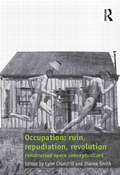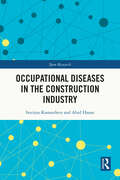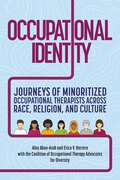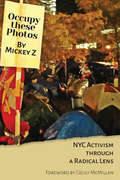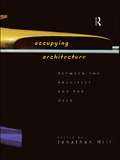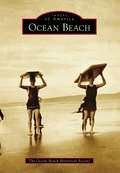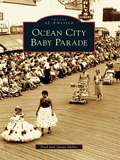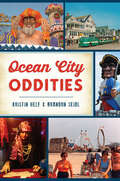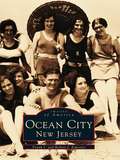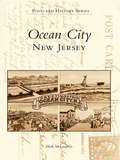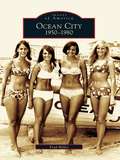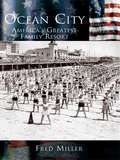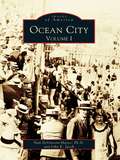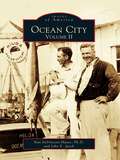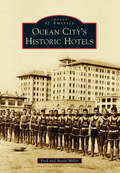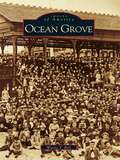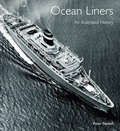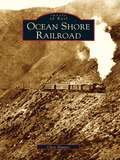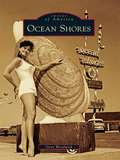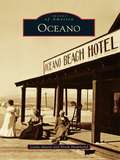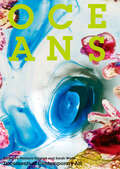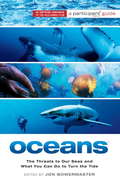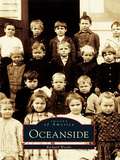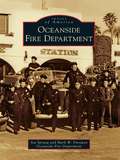- Table View
- List View
Occupation: constructed space conceptualized
by Dianne Smith Lynn ChurchillBringing together an international range of contributors from the fields of practice, theory and history, this book takes a fresh look at occupation. It argues that occupation is a prospect that begins with ruin--a residue from the past, an implied or even a resounding presence of something previous that holds the potential for transformation. This prospect invites us to repudiate, re-imagine and re-define lived space, thereby asserting occupation as an act of revolution. Authors drawn from the fields of architecture, urbanism, interior architecture, dance dramaturgy, art history, design and visual arts, cultural studies and media studies provide a unique, holistic view of occupation, examining topics such as: the authority of architecture; architecture as an act of revolution; women in hypersexual space; occupation as a serialized act of ruin; and the definition of space as repudiation. They discuss how acts that re-invent territory and/or shift boundaries--psychological, social and physical--affect identity and demonstrate possession. This theme of occupation is significant and topical at a time of radical flux, generated by the proliferation of hypermedia, and also by the dramatically shifting environmental, political and economic context of this era. The book concludes by asserting that it is through occupation (private and public: real, virtual, remembered, re-invented) that we appear or disappear as the individual or collective self, because the spaces we construct assert particular agendas which we may either contest or live in accord with.
Occupational Diseases in the Construction Industry (ISSN)
by Imriyas Kamardeen Abid HasanDespite occupational diseases in construction contributing to a significant proportion of fatalities, and permanent and temporary incapacities, they have not gained as much attention as occupational injuries from practitioners and researchers. The research in this book aims to discover occupational diseases that cause fatalities and permanent and temporary incapacities in the construction industry, along with their epidemiological causal mechanisms.Through chapters examining cancers, circulatory system diseases, respiratory system diseases, nervous system and sense organ diseases, and musculoskeletal diseases, the authors provide new knowledge and insights to help proactively prevent and control these diseases. The research underpinning the development of the book applies empirical analyses of real-world occupational disease data for the construction industry alongside a detailed review and meta-analysis of literature pertinent to risk factors and methods and strategies to prevent and/or control occupational diseases in construction.Knowing the riskiest diseases and occupations for construction workers, along with organisational and personal risk factors, is critical to optimising risk management efforts. This book should be of interest to students, researchers, and practitioners in construction management, occupational health and safety, and risk management.
Occupational Identity: Journeys of Minoritized Occupational Therapists Across Race, Religion, and Culture
by Coalition of Occupational Therapy Advocates for Diversity Alaa Abou-Arab Erica V. HerreraDelving into the diverse experiences of minoritised occupational therapists, this book contributes to the increasingly critical need for cultural humility in healthcare and discusses difficult topics surrounding culture, race, and religion with clarity and humanity.Using a wealth of research and knowledge on different cultures and communities this illuminating book focusses on a person-centred approach and encourages meaningful dialogue and self-reflection. Co-authored by the Coalition of Occupational Therapy Advocates for Diversity, this invaluable resource will allow you to journey through real-world experiences and cultural contexts through in-depth case studies and interviews from OTs at varying stages of their career.Occupational Identity will equip you with rich insights and actionable guidance in order to promote a better understanding of race, religion, and culture. Whether you're a seasoned OT, student, educator, or healthcare worker, this book will help you embrace diversity, establish better trust and communication, and deliver compassionate and culturally nuanced care that promotes better health outcomes for all.
Occupy These Photos: NYC Activism Through a Radical Lens
by Cecily Mcmillan Mickey Z.Mickey Z. continues his advocacy work by taking his camera to the streets and showing a number of major demonstrations and protests that occurred in NYC between #OWS and #BlackLivesMatter as he saw them. Not a professional photographer but a street photographer capturing those who, like him, turn out daily to protest and demand changes to an unfair and unequal system as it affects all life in NYC, human and non-human.
Occupying Architecture: Between the Architect and the User
by Jonathan HillOccupying Architecture focuses on the importance of the user of architecture. It emphasises the cross-currents between design, theory and use, and the need for a wider cross-cultural approach to architecture. Beginning with the architect, the book proceeds to explore models for architectural practice that actively engage the issue of use, and concludes with examination of the user. The authors draw on illustrations and examples from London, Las Vegas, Barcelona and Bruges to discuss how and why architecture ignores the user. The apparant contradictions between the 'producer' and the 'product' of architecture are highlighted before the activities of the architect and the actions of the user are explored.This book illustrates that architecture is not just a building: it is the relation between an object and its occupant.
Ocean Beach
by Ocean Beach Historical SocietyOcean Beach, a neighborhood of San Diego, California, is known throughout the city, county, and beyond as a unique and quirky place with the feel of a small town, despite being a stone's throw from the center of a major metropolis. Founded in 1887 in a coastal area known for its beautiful cliffs and rock formations, Ocean Beach went through growing pains in the early 1900s before establishing itself as a family-oriented, self-contained beach community by the mid-1930s. Full of mom-and-pop stores and very walkable, Ocean Beach is a favorite destination for thousands of tourists and San Diegans each year.
Ocean City Baby Parade
by Susan Miller Fred MillerThe Ocean City Baby Parade is the longest continuously held baby parade in the nation, tracing back to August 10, 1901, when the city's first baby show was held. From its beginning with 46 babies in the prettiest, cutest, and fattest baby categories, it has grown into a boardwalk extravaganza with 300 entrants, bands and bugle corps, professionally decorated commercial floats, homemade baby floats, grand marshals, and cartoon characters. Many families plan their vacations around this well-known event, and they are among the thousands of spectators lining the boardwalk each year.
Ocean City Beach Patrol (Images of America)
by Fred MillerOcean City Beach Patrol is the story of the elite group of men and women who serve as guards along the sandy beaches and gently rolling surf of Ocean City, an eight-mile-long barrier island off the coast of southern New Jersey. Although the coastline slopes gradually into the sea and the water is generally calm, deadly rip currents and strong undertows can occur at any time. Thus, the lifeguards often risk their lives to protect the thousands of bathers enjoying these waters each summer.
Ocean City Oddities
by Brandon Seidl Kristin HelfFor generations, Ocean City has afforded both locals and tourists unforgettable sights and sounds. The boardwalk holds iconic landmarks like Trimper's Rides and the Sand Sculptures, and no visitor will ever forget Boardwalk Elvis. Farther north are Motel Row, Jolly Roger's "Muffler Man" Pirate and Old Pro miniature golf courses. Nostalgic recollections from decades past include the boisterous chuckles of Laffing Sal and Captain Bob's Bull. Local authors Kristin Helf and Brandon Seidl celebrate gone-but-not-forgotten spots while also exploring the exciting landmarks that are still enjoyed today.
Ocean City, New Jersey (Images of America)
by Frank J. Esposito Robert J. EspositoOcean City, which calls itself "America's Greatest Family Resort," is today best known for its wide, clean beaches and a yearly bayfront celebration called the "Night in Venice." Founded in 1879 as a Christian seaside resort, the island community still maintains some of its early traditions including prohibiting the sale of alcoholic beverages--while striving to continue its long-standing reputation as a family-oriented resort. This remarkable new photographic history features such historic sites as the home of the town's firstresident and famous old-time restaurants like Chris', Hogate's, and Watson's. Several rare pictures of the shipwrecked Sindia and its cargo are also included, as well as photographs of Ocean City's most well-known citizens, Princess Grace Kelly and author Gay Talese.
Ocean City, New Jersey (Postcard History)
by Mark MclaughlinFrom the early 1900s through the 1950s, the postcard was an extraordinarily popular means of communication, and many of the postcards produced during this "golden age" can today be considered works of art. Postcard photographers traveled the length and breadth of the nation snapping photographs of busy street scenes, documenting local landmarks, and assembling crowds of local children only too happy to pose for a picture. These images, printed as postcards and sold in general stores across the country, survive as telling reminders of an important era in America's history. This fascinating new history of Ocean City, New Jersey, showcases more than two hundred of the best vintage postcards available. Images in this collection date between 1879 and 1950.
Ocean City: 1950-1980 (Images of America)
by Fred MillerOcean City: 1950-1980 illustrates the growth and change of this seashore community founded in 1879 by a group of Methodist ministers. The venture was an immediate success, and the area quickly grew into a prosperous year-round community and a bustling summer resort. The Great Depression and World War II slowed this development, but by the beginning of the 1950s, the burgeoning economy and optimism in the country again encouraged people to enjoy family vacations. With the wide beaches, scenic boardwalk, three new major highways, and comfortable family atmosphere, Ocean City became a superb family destination.
Ocean City: America's Greatest Family Resort
by Fred MillerNestled along the New Jersey coastline and built to be one of the original seaside tourist destinations, Ocean City still sets the standard for resort living along the mid-Atlantic. What was once a whale-processing center in the 1700s emerged as a destination for sun and fun by drawing the biggest names and the classic American families of the early twentieth century. As our country's search for the ideal vacation grew, this 7-mile stretch of beach cultivated a rich history and a reputation as one of the most alluring communities on the East Coast.
Ocean City: Volume I (Images of America)
by Ph. D. Nan Devincent-Hayes John E. JacobOriginally the land of the Algonquian people, the barrier island on which Ocean City is now located, served as a protective wall for the mainland Delmarva peninsula. It was a somewhat remote area until five men, having formed the Atlantic Hotel Company Corporation, built the first lodging facility, and Ocean City as a coastal resort began to take root. From the cattle grazing in the mid-1800s to the few blocks of buildings constructed at the turn of the century, from the infamous storm of 1933 to the overwhelming growth of the 1940s, Ocean City has had a rich and vibrant history. This volume offers a historical perspective of Ocean City from its inception to 1946, a period when growth was steady but slow. Now boasting over eight million visitors annually, the area is Maryland's golden-haired child and its second-largest city during peak summer weekends when an average of 300,000 tourists arrive.
Ocean City: Volume II (Images of America)
by Ph. D. Nan Devincent-Hayes John E. JacobOcean City, Maryland's own seaside resort, has become so popular that it is almost too small--five square miles--to hold all its tourists. The last few decades have brought tremendous growth to the area in the form of both population and development. Bridges and tunnels have been built, high-rise hotels and condominiums have grown up, and amusements of all kinds have become available to the summertime crowds. In this second volume of Ocean City, images of beach life from the late 1940s to the present day capture the spirit of this popular vacation spot. From funnel cakes to Ferris wheels and deep-sea fishing to seasonal festivals, Ocean City, now a year-round retreat, has offered millions of visitors an endless variety of entertainment. Having survived destruction caused by storms, problems associated with the real estate boom, and the overwhelming surge of visitors who each summer crowd the boardwalk and Coastal Highway, this "small" town has matured over the last few decades into the jewel of Maryland's shore.
Ocean City’s Historic Hotels
by Susan Miller Fred MillerOcean City, New Jersey, was founded as a "Christian seaside resort" in 1879. Soon thereafter, it became a vibrant year-round community and a highly desirable summer retreat. Hotels were integral to the city's success. The most famous of these was the Flanders Hotel, which opened to much fanfare in 1923. It was built in the Spanish Mission Revival style and named after Belgium's Flanders Field; today, it is in the National Register of Historic Places. In addition to other stately hotels, such as the Brighton, the Biscayne, and the Bellevue, many smaller hotels and guesthouses, like Jernee Manor, the Castle Inn, Locksley Hall, and the Scarborough Inn, were also established. Ocean City's Historic Hotels features the rich architectural and recreational history of this New Jersey coastal town and its many hotels.
Ocean Grove (Images of America)
by Wayne T. BellIn 1869, a group of ministers and religious faithful established a permanent Methodist camp meeting community on the North Jersey shore. A state charter was issued one year later, and the community of Ocean Grove was born. Following the example set by other camp meetings, Ocean Grove became a center for religious revivals. The town continued to flourish as railroad and steamship lines transported passengers eager to escape the nearby crowded cities. For more than one hundred years, Ocean Grove has provided a retreat to those wishing to return to a life of religious renewal and recreation. Ocean Grove is a detailed look at the growth of this unique seaside community. Home to the largest aggregate of Victorian and early-twentieth-century structures in America, Ocean Grovecontinues to provide its visitors with a glimpse into the past. Ocean Grove has maintained its custom of holding summer camp meetings for over one hundred-thirty years. These annual revivals have attracted such notable speakers and guests as William Jennings Bryan, Booker T. Washington, and Presidents Grant and Roosevelt to the Great Auditorium. Since its conception, Ocean Grove has been home to an uncommon history, making Ocean Grove a treasure.
Ocean Liners: An Illustrated History
by Peter Newall&“A truly comprehensive publication, running the gamut from the first Atlantic sail-enhanced steamers to today&’s remaining handful of combi-liners.&” —Maritime Matters Before the advent of the jet age, ocean liners were the principal means of transport around the globe, and carried migrants and business people, soldiers and administrators, families, and lone travelers to every corner of the world. Though the ocean liner was born on the North Atlantic it soon spread to all the other oceans and in this new book the author addresses this huge global story. The account begins with Brunel&’s Great Eastern and the early Cunarders, but with the rise in nationalism and the growth in empires in the latter part of the 19th century, and the opening of the Suez Canal in 1869, the colonial powers of Spain, France, and Germany soon established shipping lines of their own, and transpacific routes were opened up by Japanese and American lines. The golden age between the two world wars witnessed huge growth in liner traffic to Africa, Australia and New Zealand, India, and the Far East, the French colonies, and the Dutch East and West Indies, but then, though there was a postwar revival, the breakup of empires and the arrival of mass air travel brought about the swan song of the liner. Employing more than 250 stunning photographs, the author describes not just the ships and routes, but interweaves the technical and design developments, covering engines, electric light, navigation and safety, and accommodation. A truly unique and evocative book for merchant ship enthusiasts and historians.
Ocean Shore Railroad
by Chris HunterWith one of the world's most scenic backdrops as a brilliant seascape for passengers, the Ocean Shore Railroad skirted northern California's coastline to service communities south of San Francisco for the first two decades of the 20th century. As impressive as it was idealistic, the line was held prisoner by natural forces that eventually took too much of a toll to keep its striking route churning. Today's Highway 1 traces the passage once paved with tracks, and points to the few remnants of one of California's most well-known excursion lines.
Ocean Shores
by Gene WoodwickOcean Shores was the newest city in Washington for nearly 40 years, but for centuries before it had been a place of permanent occupation and food gathering for Native American tribes and a place for sea otter hunters, pioneers, and settlers to reach the interior of the Olympic Peninsula. Before Ocean Shores, there was the dream of a town called Cedarville followed by the reality of Lone Tree with its post office and 200 residents. Point Brown Peninsula was a village of survival for Polynesian Kanakas, Finns living on the edge of society, migrant workers called Bluebills, and a Hooverville for Depression-era families. After World War II, when developers first conceived of creating a "Venice of the West," many said their dream would never last. However, in 1970, Ocean Shores became a city and today has entered its 50th year of development.
Oceano
by Linda Austin Norm HammondOceano is a California beach town between San Francisco and Los Angeles. Originally part of the Rancho El Pismo Mexican land grant of 1840, Oceano first appeared as a place name on a map in 1893 and was promoted as a beach resort soon after the Southern Pacific Railroad arrived in 1895. While most of these promotions failed during the Great Depression, the railroad depot continued as a shipping point for the area's agriculture. During this time, Oceano became a point of entry for the "Dunites," a group of artists, writers, and poets who once lived in the sand dunes south of town. Today Oceano is still the primary access and gateway to its state park beach and large sand dune complex. Many people come to enjoy the experience of driving on the beach, camping there, and venturing into the dunes on foot or by vehicle.
Oceans (Whitechapel: Documents of Contemporary Art)
by Sarah Wade Pandora SyperekOCEANS attends to the inextricable human and nonhuman agencies that affect and are affected by the sea and its running currents within contemporary art and visual culture.Oceans cover more than 70 percent of the Earth&’s surface, dividing and connecting humans, who carry saltwater in their blood, sweat and tears. They also represent a powerful nonhuman force, rising, flooding, heating and raging in unprecedented ways as the climate crisis unfolds. Artists have envisioned the sea as a sublime wilderness, home to mythical creatures and bizarre species, a source of life and death, a site of new beginnings and tragic endings, both wondrous and disastrous. From migration to melting ice caps, the sea is omnipresent in international news and politics, leaking into popular culture and proliferating in recent art and exhibitions. This anthology gathers artists and writers to address the ocean not only as a theme but as a major agent of artistic and curatorial methods.Artists surveyed includeBas Jan Ader, Eileen Agar, John Akomfrah, Heba Y. Amin, Shuvinai Ashoona, Betty Beaumont, Leopold & Rudolf Blaschka, Heidi Bucher, Marcus Coates, Tacita Dean, Chris Dobrowolski, Léuli Eshrāghi, Ellen Gallagher, Ayesha Hameed, Barbara Hepworth, Klara Hobza, Isuma, Brian Jungen, Tania Kovats, Sonia Levy, Armin Linke, Lani Maestro, Ana Mendieta, Kasia Molga, Eleanor Morgan, Wangechi Mutu, Saskia Olde Wolbers, Jean Painlevé and Geneviève Hamon, Allan Sekula, Shimabuku, Ahren Warner, Christine & Margaret Wertheim, Alberta WhittleWriters include Stacy Alaimo, Bergit Arends, Erika Balsom, Karen Barad, Rachel Carson, Mel Y. Chen, T.J. Demos, Marion Endt-Jones, Kodwo Eshun, Paul Gilroy, Stefano Harney, Epeli Hau&’ofa, Donna Haraway, Eva Hayward, Stefanie Hessler, Luce Irigaray, Zakiyyah Iman Jackson, Celina Jeffery, Melody Jue, Max Liboiron, Lana Lopesi, Chus Martínez, Jules Michelet, Fred Moten, Astrida Neimanis, Celeste Olalquiaga, Ralph Rugoff, John Ruskin, Marina Warner, Jan Verwoert
Oceans: The Threats to Our Seas and What You Can Do to Turn the Tide
by Participant Productions Jon BowermasterThis unique tie-in to the major motion picture Oceans--coming this April from Disney & National Geographic--explores the health of our oceans, and what we can do to improve it. More than 75 percent of the globe is covered by the oceans. It is sometimes difficult to understand why it is called Planet Earth rather than Planet Ocean. Since half the world's human population lives within a stone's throw of an ocean coastline, the oceans' health is increasingly important. Rich with resources and potential--as a source of renewable energy, new drugs, drinking water--for years we have treated them as both infinite and undamageable. But they are not. Over-fishing, climate change, pollution, acidification, and more have put the world's oceans and marine life at great risk. Oceans gathers some of the most insightful visionaries, explorers, and ocean lovers-- marine biologists, politicians, environmentalists, fishermen, sportsmen, deep divers, and more--in a unique anthology, in which each speaks to a unique aspect of our world's most dimly understood dimension.
Oceanside
by Richard WoodsOceanside is a close look at a community whose history begins with the history of Long Island. Captured in these images is the south shore town that was once one of the largest oyster-producing communities in the world. It is a place that, over the years, has attracted farmers, baymen, middle-class families, and millionaires. It has also drawn more than its share of visitors to St. Anthony's underground church, Beall's Zoo, the Roadside Rest, and Nathan's Famous Restaurant.
Oceanside Fire Department (Images of America)
by Mark W. Finstuen Stu Sprung Oceanside Fire DepartmentFor more than 120 years, the firefighters of the Oceanside Fire Department have had the privilege of serving one of Southern California's most active and popular coastal communities. Its firefighters are well known regionally as being highly skilled, capable, and aggressive when it comes to firefighting. This legacy has been handed down from Oceanside's first firefighters as they lived in the Wild West of the late 1800s, fighting blazes similar to those of today but with dungarees, cowboy boots, and nothing to guide them but instinct and bravery. Today a force of more than 100 modern, paramedic-trained firefighters protect over 180,000 Oceanside residents and visitors 24 hours a day, 365 days a year.
